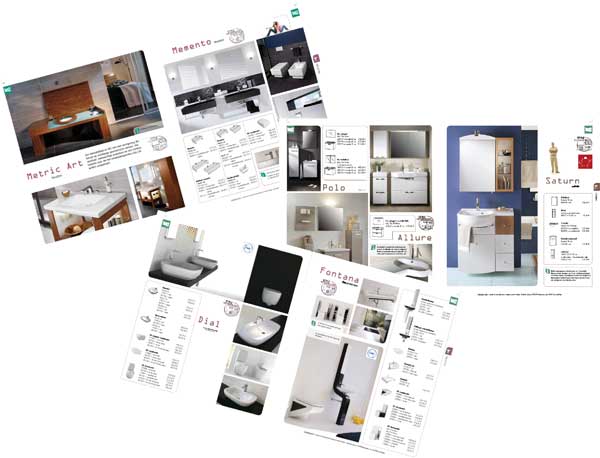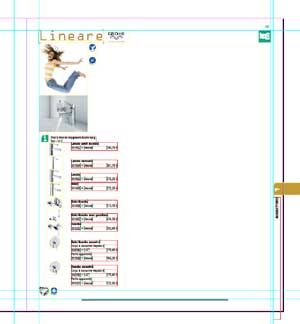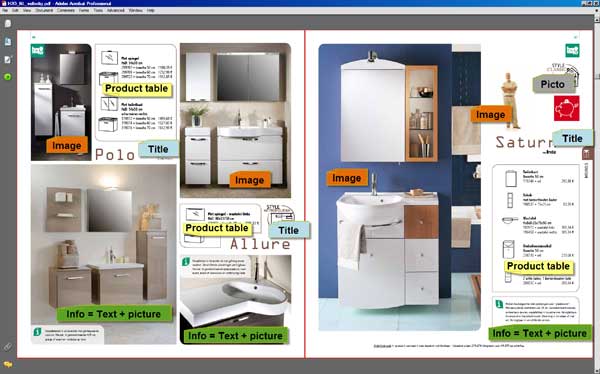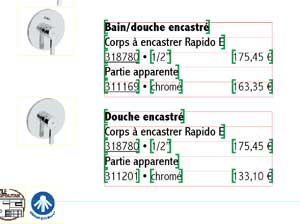Leaflet / Indesign workflow
Here is an example of a real catalog of more than 450 pages where all pages have a different structure.

How can a database assisted workflow be interesting for B2C catalogs?
While this catalog has been laid out manually for years, the transition to a workflow supported by a database was considered interesting for two main reasons:
- This publication contains many product references (over 3,000). Some of the data (eg prices) can be found in existing systems. Manual update takes a long time and is a source of (too) many mistakes.
- Like many catalogs, between 10 and 30% of the content changes each time. These adjustments also take a lot of time and can be separated into two distinct job profiles:
- An administrative part which consists of collecting all the new data changes (data and images). This job should be done by “product” experts being comfortable in the hunt for data in the organization or at external suppliers.
- A creative part to be done by graphic designers with DTP skills
A workflow that can better separate these two profiles, will bring positive changes to the organization.
The following improvements and savings were achieved:
- We were able to reduce the elapsed time for a new edition from 6 to 3 months (While switching at the same time from a manual workflow to a semi-automatic workflow).
- Cost per page of the first new edition was not much higher than traditional outsourcing. Regarding subsequent editions, it is expected that the cost per page will be about half the one of an entirely manual workflow.
- When content comes from a database, it is possible to quickly identify errors and this with more complementary techniques than rereading the document again.
- Drafts of pages can be generated without waiting for the final layout. Each member of the team working on the new edition can at any time assess the status of a (set of) page (s). It is then easy to unsync data encoding and creative layout. Managers don’t have to wait on the layout to get a first draft and creatives don’t have to wait for encoding is finished to start the layout.
- Team communication around the document is articulated through the database instead of spread across several classic and inappropriate channels for efficient transfer of data (email, phone, post-its, paper, etc. …)
Workflow Leaflet + Indesign

The workflow is combined: Leaflet + Indesign.
Leaflet generates drafts of pages. A PDF of these pages may be requested for review or they can be exported to Indesign where the final layout is obtained as usual. Generating pages and export are the “Leaflet” speed, ie in seconds. A plug-in enables InDesign to update data after export. The layout is 100% free and the data from the database to 100%.
Left a sample of a draft page as generated by Leaflet.
Each page is a collection of templates Leaflet basic. This type of document has a different layout for each page. A new page is typically made from a collection of basic templates as you can see in the example below.
In the catalog taken as an example, the following templates were involved in the composition: “Image”, “Table”, “Title”, “Info”, “Picto”. All pages have been constructed from these “blocks” basic.
Apart from “Table”, all other templates are simple. The template “Table” processes data on four product levels using many opportunities for conditional text. This is where Leaflet stands out in particular, more complex layout becomes more Leaflet justified!

The benefits are twofold for the graphic:
- All necessary layout objects were poses on Indesign page No time wasted looking for the instructions or scattered across several sources missing data, it can focus on its core business.
- Thanks to dynamic templates Leaflet Groups of complex objects like tables come formatted as agreed in the graphic. The designer need only drag to the right place. The total time for the layout is drastically reduced. In this document a rate of 4 pages / hour has been reached (Considering that there is a layer containing a second language).
Objects are marked for a later update the plug-in Indesign

Leaflet export templates with tagged data for a later update as you can see in InDesign (see example at left). All technical data for the link with the database are also included in the export.
Plug-in InDesign uses these tags to update the data. This applies both to the images than text.
While an automatic catalog may mostly be completely rebuilt every edition, a semi-automatic publication can not. When 30% of the document changes, it is imperative to keep the other 70% as is. It is therefore of vital importance to be able to apply changes to a document efficiently exist.
In InDesign, from the previous edition, is deleted, adding pages and blocks are moved from one page to another where necessary.
In the database at any time, a “sync” with Indesign document may be requested. This updates the page numbers of blocks found in both the database and the InDesign file and identifies orphans each side (only blocks found in the database and blocks present only in the InDesign file.) The operator reconciles orphaned by exporting the new blocks to the document Indesign or deleting them in the database or document Indesign.
This “sync” can work in InDesign and database independent. Nobody expects and it is quite easy to know at every moment what blocks and which pages should be refreshed.
All contents blocks are marked for update by the plug-in. But what’s going on when the contents of a block has changed so much that an update is not enough? (Eg additional products in a table. These products can not be updated because they do not exist in the table Indesign).
In this case, through the screens of the database or the InDesign plug-in, it is possible to export a new copy of a block Leaflet. This new copy can be placed next to the existing (for copy / paste part for example) or it can replace the existing block in the same place. The new copy will contain all the data. Monitoring the status of each block in the database allows you to concentrate on the blocks that need to be replaced even in a publication containing several hundred pages and contains thousands of blocks.
